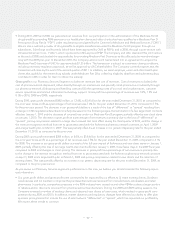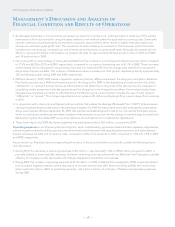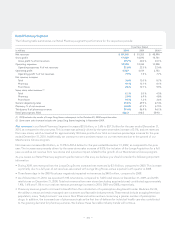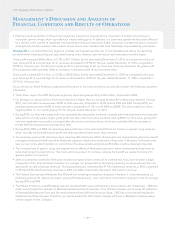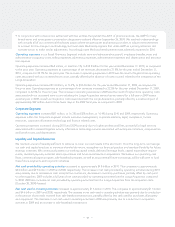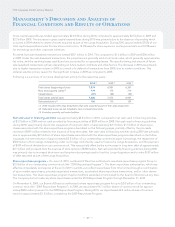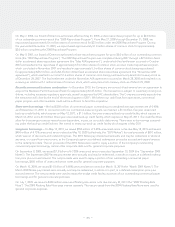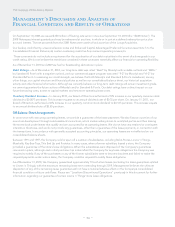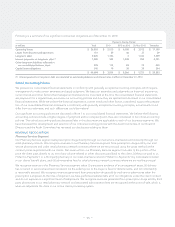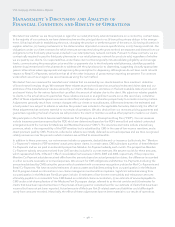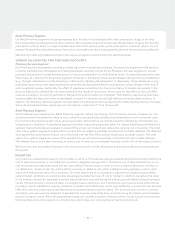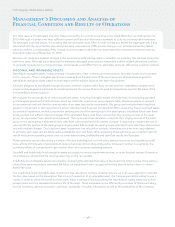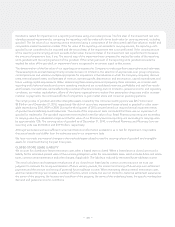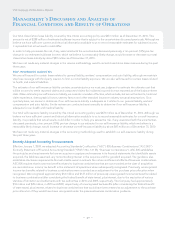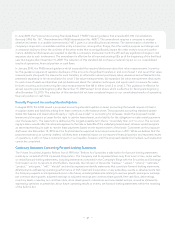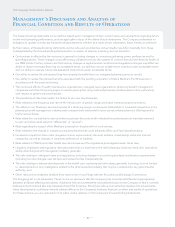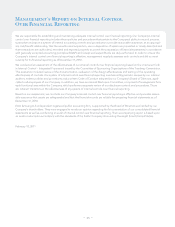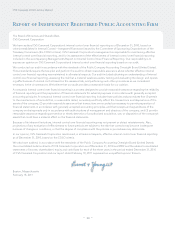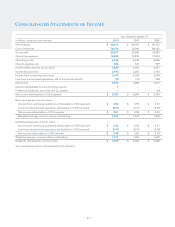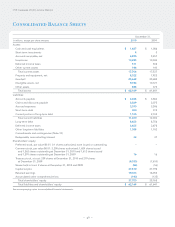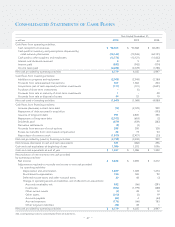CVS 2010 Annual Report Download - page 41
Download and view the complete annual report
Please find page 41 of the 2010 CVS annual report below. You can navigate through the pages in the report by either clicking on the pages listed below, or by using the keyword search tool below to find specific information within the annual report.
Retail Pharmacy Segment
Our Retail Pharmacy segment recognizes revenue from the sale of merchandise (other than prescription drugs) at the time
the merchandise is purchased by the retail customer. We recognize revenue from the sale of prescription drugs at the time the
prescription is filled, which is or approximates when the retail customer picks up the prescription. Customer returns are not
material. Revenue from the performance of services in our health care clinics is recognized at the time the services are performed.
We have not made any material changes in the way we recognize revenue during the past three years.
VENDOR ALLOWANCES AND PURCHASE DISCOUNTS
Pharmacy Services Segment
Our Pharmacy Services segment receives purchase discounts on products purchased. Contractual arrangements with vendors,
including manufacturers, wholesalers and retail pharmacies, normally provide for the Pharmacy Services segment to receive
purchase discounts from established list prices in one, or a combination of, the following forms: (i) a direct discount at the time
of purchase, (ii) a discount for the prompt payment of invoices or (iii) when products are purchased indirectly from a manufacturer
(e.g., through a wholesaler or retail pharmacy), a discount (or rebate) paid subsequent to dispensing. These rebates are recog-
nized when prescriptions are dispensed and are generally calculated and billed to manufacturers within 30 days of the end of
each completed quarter. Historically, the effect of adjustments resulting from the reconciliation of rebates recognized to the
amounts billed and collected has not been material to the results of operations. We account for the effect of any such differ-
ences as a change in accounting estimate in the period the reconciliation is completed. The Pharmacy Services segment also
receives additional discounts under its wholesaler contract if it exceeds contractually defined annual purchase volumes. In
addition, the Pharmacy Services segment receives fees from pharmaceutical manufacturers for administrative services. Purchase
discounts and administrative service fees are recorded as a reduction of “Cost of revenues”.
Retail Pharmacy Segment
Vendor allowances received by the Retail Pharmacy segment reduce the carrying cost of inventory and are recognized in cost
of revenues when the related inventory is sold, unless they are specifically identified as a reimbursement of incremental costs
for promotional programs and/or other services provided. Amounts that are directly linked to advertising commitments are
recognized as a reduction of advertising expense (included in operating expenses) when the related advertising commitment is
satisfied. Any such allowances received in excess of the actual cost incurred also reduce the carrying cost of inventory. The total
value of any upfront payments received from vendors that are linked to purchase commitments is initially deferred. The deferred
amounts are then amortized to reduce cost of revenues over the life of the contract based upon purchase volume. The total
value of any upfront payments received from vendors that are not linked to purchase commitments is also initially deferred.
The deferred amounts are then amortized to reduce cost of revenues on a straight-line basis over the life of the related contract.
We have not made any material changes in the way we account for vendor allowances and purchase discounts during the past
three years.
INVENTORY
Our inventory is stated at the lower of cost or market on a first-in, first-out basis using the retail method of accounting to determine
cost of sales and inventory in our CVS/pharmacy stores, weighted average cost to determine cost of sales and inventory in our
mail service and specialty pharmacies and the cost method of accounting on a first-in, first-out basis to determine inventory in
our distribution centers. Under the retail method, inventory is stated at cost, which is determined by applying a cost-to-retail
ratio to the ending retail value of our inventory. Since the retail value of our inventory is adjusted on a regular basis to reflect
current market conditions, our carrying value should approximate the lower of cost or market. In addition, we reduce the value
of our ending inventory for estimated inventory losses that have occurred during the interim period between physical inventory
counts. Physical inventory counts are taken on a regular basis in each store and a continuous cycle count process is the primary
procedure used to validate the inventory balances on hand in each distribution center and mail facility to ensure that the amounts
reflected in the accompanying consolidated financial statements are properly stated. The accounting for inventory contains
uncertainty since we must use judgment to estimate the inventory losses that have occurred during the interim period between
physical inventory counts. When estimating these losses, we consider a number of factors, which include, but are not limited to,
historical physical inventory results on a location-by-location basis and current physical inventory loss trends.
– 37 –


